Bethesda and St. Anne's
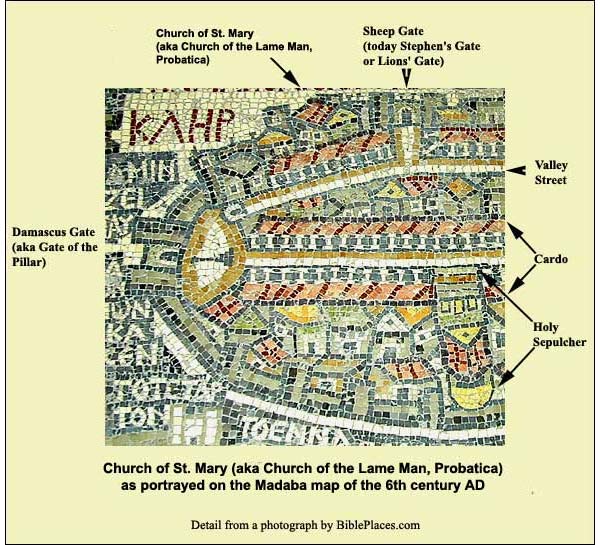
The Church of St. Mary was probably damaged or destroyed by the Persians, when they invaded in 614. After their withdrawal 14 years later, the Christians restored it on a smaller scale. Perhaps the early church was already identified as Mary's birthplace, but the first extant written testimony comes from the pen of the patriarch Sophronius, shortly before the Muslim conquest of 638:
I will enter the holy Probatic church, where Anne, the saintly woman, gave birth to Mary. I will enter the restored temple of the Mother of God... Let me see the spot where the impotent man, restored to health at the bidding of the Word, took up his bed and walked away."
Let' deal with each tradition separately, then see how they may connect.The PoolsAs Jerusalem grew through history, and as increasing numbers of pilgrims arrived for the festivals, new sources of water had to be found. Every potential source was exploited. There is a natural drainage basin that starts near today's American Colony Hotel, about a kilometer north of the Old City, and deepens into a valley just outside the northern Old City wall. This valley drops 60 meters over a north-south stretch of 470 meters, passing west of St. Anne's Church, continuing beneath the northeast section of the Temple Mount and joining the Kidron Valley just north of the Golden Gate. Despite the debris that's piled up through the centuries, you can still make it out in the picture on the right (by clicking to enlarge it). It has long been thought that the first to catch the run-off in this valley were the Judahites in the 8th century BC, and they caught it in what Isaiah 7:3 calls "the Upper Pool." It may be so, but a recent archaeological examinationGibson, S. The excavations at the Bethesda Pool in Jerusalem: Preliminary Report on a Project of Stratigraphic and Structural Analysis (1999-2009). Proche-Orient chrétien, ISSN 0032-9622. - (2011) no. spécial, p. 17-44. has found no structural evidence before the early Roman period. As for the Upper Pool of Isaiah, it may turn out to have been the so-called "Pool of Hezekiah" in the Old City near the Jaffa Gate, because a conduit from that time has been discovered to the west of it in the Mamilla area. Likewise, the southern Pool of Bethesda used to be attributed to Simon the High Priest around 200 BC, on the basis of a verse in Ben Sirah, also known as Ecclesiasticus (50:3): "In his time the reservoir was dug, the pool with a vastness like the sea's." But the recent study has turned up no structures that go back so far.The two pools together encompassed a water surface of about 5000 square meters. The small section of the southern pool that has been excavated down to bedrock shows a depth of 13 meters.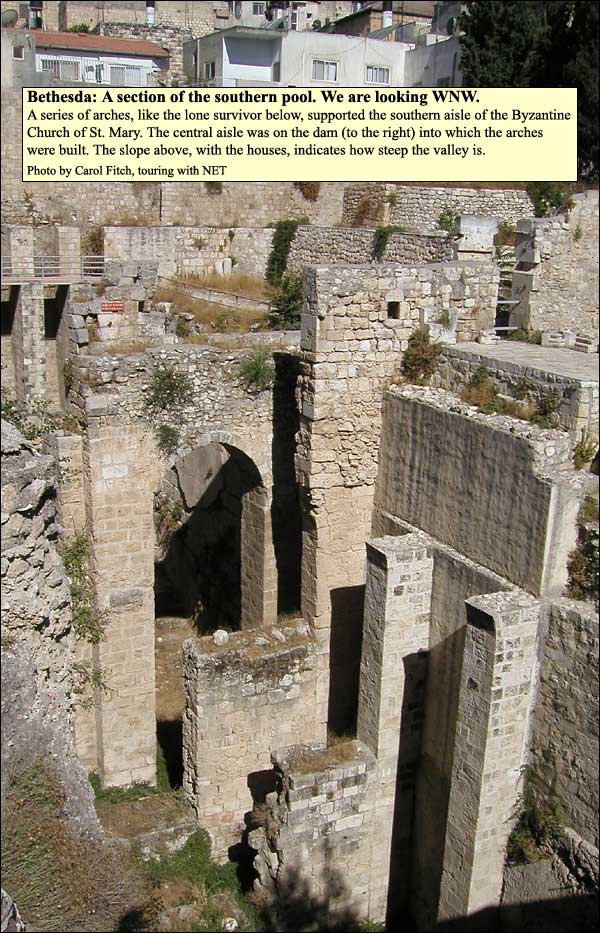
Herod the Great dug an even bigger pool into the same valley just south of here, as part of his Temple-expansion project. It was called the Pool of Israel. It had more than twice the depth that you see above. It was 110 meters long, on an east-west axis, and 38 wide. In the 1930's, the municipality filled it, and today it is buried beneath a parking lot. (Bahat p. 33Bahat, Dan. The Atlas of Biblical Jerusalem. Jerusalem: Carta, 1994.) To the left is a drawing of the Pool of Israel as it looked in 1850.Did the two pools and the Pool of Israel function together? Or did the last make the two superfluous? Scholars differ on these questions. It seems clear, though, that Jerusalem did need a great deal of water in Herod's day. Since he doubled the size of the Temple platform to accommodate hundreds of thousands of pilgrims (today, 400,000 sometimes pray here during Ramadan), water would have been required not just for drinking and ritual bathing, but also for cleaning sacrificial animals and, afterwards, for washing away their blood. Herod found water at springs in the Judean range, leading it through aqueducts into cisterns beneath the Temple platform. (There are 34 known cisterns with a capacity of 40,000 cubic meters or about 10 million gallons. Some of them were in use until 1924, when piped water was introduced.) Perhaps he supplemented the runoff to the pools in St. Anne's Valley with water from these same aqueducts. We can now consider the basic question: Are the two pools the same as the one that is talked about in John 5 (quoted above)? The use of the singular "pool" does not speak much against it: the evangelist might have considered the two as one, with four porches surrounding both and the fifth on the dam. In his commentary on John in the third century, Origen understood the matter this way, and Eusebius seconded him in the fourth. The reference to sheep is helpful. Sheep would have been brought in from the desert, to which the northeastern corner of the city is the most accessible. Until 1990 or so, the sheep market always took place on Friday outside the wall there. The evidence that brings us closest to Jesus' time is found in the Copper Scroll from a cave at Qumran. Engraved in copper foil, it can be dated by its Hebrew script to 25-75 AD. The scroll presents a list of places where treasure is hidden. In sections 57 and 58, we read (following John Wilkinson, p. 96Jerusalem as Jesus Knew It: Archaeology as Evidence. London: Thames and Hudson, 1978.): "Near there at Bethesdatain: in the pool, where one goes into the small pool is a jar of aloe wood and one of resin of white pine. Near there at the west entry of the porch of the Triclinium near the place for the Stove is nine hundred talents of silver and five talents of gold." Here the name Bethesda occurs in dual form (like the Hebrew for hands or feet), which might refer to the two pools. Bethesdatain could be the original name, composed of the root for "house" (beth) and that for "waterfall" or "outpouring" (eshed). (Yet "esda" could come instead from the root for "grace" or "mercy" (khesed.) In the transition from Hebrew to Aramaic (which was more commonly spoken then), the dual form is often lost. Bethesdatain became Aramaic Bethesda. (For this and more, see Finegan p. 228Jack Finegan, The Archeology of the New Testament, Revised edition, Princeton: Princeton University Press, 1992). Apart from the name's dual form, the body of the text refers to more than one pool, because otherwise there'd be no sense in distinguishing "the small pool" (literally, "small sea"). Since there was no other pair of pools in Jerusalem, the identification of this site as Bethesda seems plausible. We may add the fact that later generations accepted it without question. How did Bethesda function, though, as a site for healing? One factor is the presence of a broad staircase cut into bedrock in the southern pool. If the steps had been originally intended merely for cleaning the pool, a narrow staircase would have sufficed, and there wouldn't be the occasional broad step. We find this design at other monumental staircases: in this land, for example, at the south side of the Temple, at the Tomb of the Kings, at Chorazin, and at the recently discovered Herodian Pool of Siloam.There must have been much traffic on this staircase, such as there would have been when pilgrims were cleaning sheep and other animals for sacrifice. Supposing that the Pool of Israel superseded the two of Bethesda, these would have held less water. Then a belief might have arisen that the water at Bethesda would heal the first to get in when it moved without apparent natural cause. We can picture the rush down the steps and the sick man who'd been coming there for 38 years: "Sir, I have no one to put me into the pool when the water is stirred up, but while I'm coming, another steps down before me."That is one possibility, and to the mind of this writer it best fits the account in John 5. There is an alternative proposal, made by scholars who worry about the enormous depth of the pools, which they think would have made them prohibitive for the lame and the paralyzed. But that was of course the man's problem! And these scholars do not take sufficient account of that staircase. Among those proposing an alternative is John Wilkinson (pp. 53-65, 95-104)Jerusalem as Jesus Knew It: Archaeology as Evidence. London: Thames and Hudson, 1978.. Whether or not we find his specific thesis persuasive, his broader insights are very illuminating. In a bold interpretation, he proposes that it was Herod himself who gave the pools their shape. He believes that Herod redesigned most of Jerusalem's streets in accordance with two grid patterns. The lines of one grid were determined by his palace on the western side of the city, the lines of the other by the Temple. The dam between the pools formed part of a street in the Temple-determined grid. On the east this street would have ended, he suggests, at a building called Bethesda, which may be translated, we have seen, as the House of Mercy (or Grace). This building might have had the five porches John mentions.
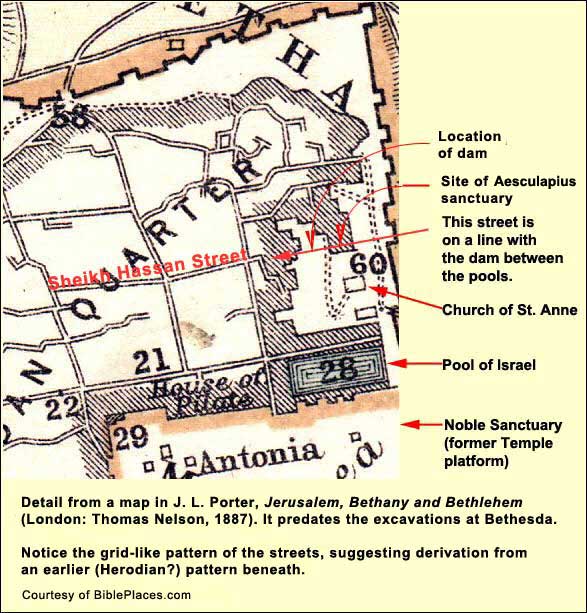
No trace remains of the House of Mercy, because a temple of Aesculapius, the Greek god of healing (or his Egyptian equivalent Serapis), replaced it around 135 AD (when the Roman emperor Hadrian conquered Jerusalem and banished its Jews). In the bedrock just east of the dam, archaeologists discovered an elaborate network of small plastered caves. The finds included part of the engraving of a snake, the symbol of Aesculapius (and, ever since, the symbol of medicine). They also found part of a marble foot dedicated (in hope or in gratitude) by one Pompeia Lucilla. The caves were probably medicinal baths for use in the Aesculapius cult. Given the account in John, which was written before the founding of the pagan temple, we may infer that the Romans were picking up on a reputation that the site already had as a place of healing. The Aesculapius temple was supplanted by the Church of St. Mary. The builders of the latter went out of their way to eradicate the pagan shrine. They covered its site with the eastern end of their basilica, even though, to get the length they wanted, this required suspending the southern aisle on arches over the pool (as seen above).Wilkinson and others have proposed that the small medicinal baths were taken over by the pagan cult but were already in place when Jesus visited. Some scholars include a cistern adjoining the north side of the dam. One can enter this cistern today by a narrow flight of steps. We recall the description in the Copper Scroll: "in the pool, where one goes into the small pool." Yet all the candidates are too small, and too private, to have functioned in the way the Gospel leads us to picture events. People would have had to line up in single file, and the one to see the water moving would have been first in - or been trampled. Wilkinson admits that he's at odds with JosephusJosephus Flavius (36 – 100 AD), Jewish general, one of two directing the revolt against Rome in Galilee. After Vespasian captured him, he prophesied the latter would be emperor. When this proved true, the Romans honored him. He then turned historian, writing The Jewish War, The Antiquities of the Jews and many other books. Because of a paragraph about John the Baptist (and maybe a sentence about Jesus), the Church preserved his works. on one point. The latter holds that Herod's walled city did not extend north of the Antonia Fortress; his grandson, Agrippas, expanded it. But Josephus may have been wrong. Agrippas did expand Jerusalem indeed, but Josephus was only seven then, and he may not have been accurate in recalling how much of the city was already in place when Agrippas began the work.In Wilkinson's concept, then, there was a sanctuary named Bethesda, the House of Mercy, at the end of the street. We can accept this without accepting the notion that John 5 relates to the smaller baths. The "House of Mercy" has another thing going for it, namely, that the place became associated with Anne, mother of Mary. For who was Anne? Let us enter her church. But before we do, we should note one further, tantalizing possibility. There are remains of yet another pool, a small one, which was apparently part of the same system. It lies, partly filled, just outside today's Stephen's Gate and a few steps to the north. It is called the Pool of the Bath of Our Lady Mary. (Wilkinson, p. 96Jerusalem as Jesus Knew It: Archaeology as Evidence, London: Thames and Hudson, 1978.)Logistics: Open 8.00 am - 12.00 noon, 2.00 pm - 5.00 pm. Modest dress required. There is a museum, normally closed, to which one may gain entry on request. Telephone: (02) 6283285. {mospagebreak title=Church of St. Anne}The Church of St. AnneSt. Anne's, by common agreement, is the most beautiful church in Jerusalem, both visually and acoustically. It has purity, simplicity and grandeur. It transforms many a group of middling singers into a choir of angels. It was built by the Crusaders in the 12th century to honor the birth of the Virgin Mary, which they believed took place in a cave that today is the crypt. They soon had to enlarge it for a bigger congregation, moving the facade seven meters to the west (as a change in the masonry testifies). The style is called Romanesque.The Crusaders also built a small chapel on the dam that had separated the pools of Bethesda. As the picture shows, the latter is in somewhat worse condition than its contemporary, St. Anne's.
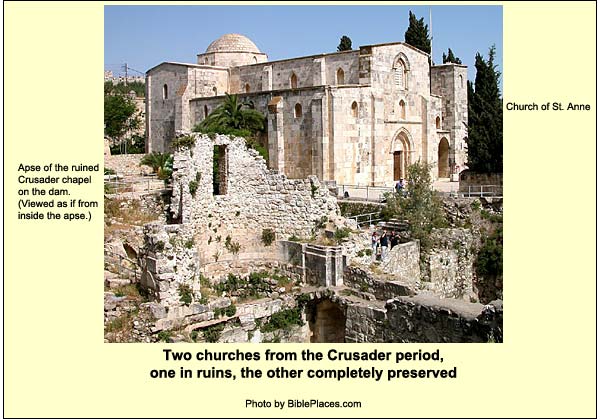
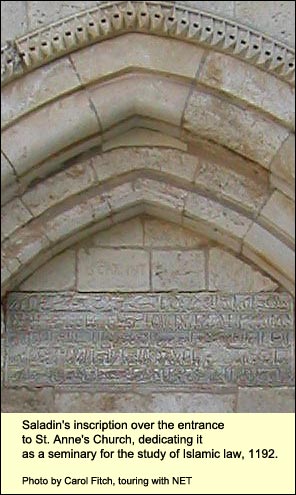
One reason for this difference is that the ruined chapel was built over a cistern, whereas the Church of St. Anne is on bedrock. Another reason goes back to Saladin. After conquering Jerusalem from the Crusaders in 1187, he transformed the (relatively new) Church of St. Anne into a seminary for the study of Islamic law. An Arabic inscription over the entrance records the date as the equivalent of 1192.Until the beginning of the 18th century, Christians were still permitted to hold Mass in the church on the Feasts of the Annunciation and Mary's birth (Nativity). Afterwards, however, the Muslim seminary ceased to function. Rumor spread that the place was haunted. In 1854, the Ottoman army was using it as a stable. Two years after that came a change of fortunes. The Ottomans had received help from France during the Crimean War against Russia. In gratitude (and to avoid conceding rights elsewhere), the Sultan bestowed the church on Napoleon III, who turned it over to a French missionary group called the White Fathers. They found the interior in a terrible state. Rubbish rose to the roof. With an architect named M. Mauss, the Fathers undertook an extensive restoration in the 1860's, giving us the church we see - and hear - today.
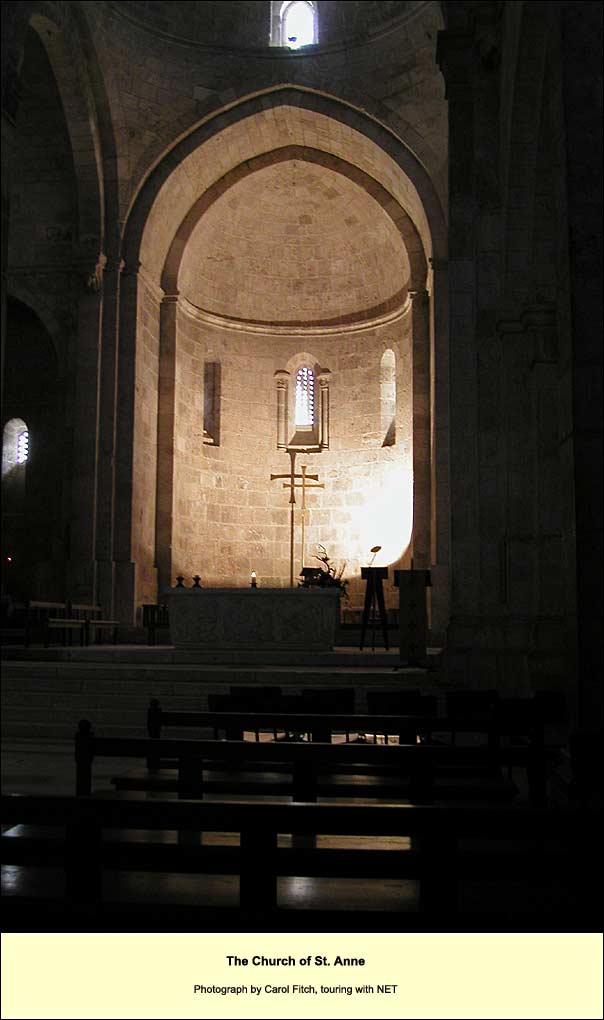
But why did tradition locate Mary's birthplace here? If there had been a real memory of this event, we'd expect Origen (3d century) to mention it, or Eusebius (4th century). They don't. Sometime before 427, however, the Christians erected a basilica, which was partly suspended on arches over the southern pool. (One arch remains.) Pilgrims called the basilica the Church of St. Mary. It underwent damage or destruction by the Persians in 614, but it must have been restored. Just before the Muslim conquest in 638, Sophronius, the patriarch of Jerusalem, linked it to two events: the healing at the pool in John 5 and the birth of Mary. Why this connection to Mary? The answer may lie in the immense popularity, during the Byzantine period, of a gospel from the 2nd century that never made it into the canon: the Protevangelium of James. This recounts the Biblical story in glowing detail, telling us many things that we wouldn't know otherwise, including the names of Mary's parents. At its beginning, we hear that Anna and Joachim were long unable to have a child. Thinking he wasn't pure enough, Joachim retired to the desert, where he fasted forty days and nights. Anna, feeling widowed as well as childless, prayed for offspring. When an angel announced that her prayer had been answered, she promised that the child would minister to the Lord "in holy things all the days of its life." Joachim returned, having heard a similar proclamation. In due time, Anna bore Mary. She created a sanctum of purity in her house, allowing nothing to enter that might defile the babe. After three years the parents fulfilled her vow, delivering the child to the priests at the Temple. When she reached the age of twelve, however, the girl could no longer legally stay in the Temple for fear that she might contaminate it. (The monthly period was and is regarded as a source of ritual impurity in orthodox Judaism, so contact with a menstruating woman is avoided.) The High Priest Zacharias (whom we know from Luke 1) conducted a test to find a guardian for her. The lot fell on an old widower named Joseph. The account then moves to the annunciation by Gabriel. The events occur near the Temple in Jerusalem - Nazareth receives no mention in the Protevangelium of James (despite the Church of St. Gabriel in that town). Basically, the account of Anna copies the story of Hannah that opens 1 Samuel. ("Anna" is the Latin version of the Hebrew "Hannah.") Despised because of her barrenness, Hannah prays for offspring, vowing that the child will serve the Lord "all the days of its life." After Samuel is weaned, she gives him to the High Priest Eli, and the boy grows up in what was then the equivalent of the Temple: the sanctuary of the Lord at Shiloh. Enchanted by the Protevangelium, the Byzantines would have sought the house of Anna. They would have looked for it near the Temple, and perhaps, since Joachim was a wealthy shepherd, near the sheep market on the northeast side. Above all, they had the name Bethesda. It may have been derived from the Aramaic beth hisda, meaning the House of (beth) Mercy (or Grace). The Hebrew equivalent of hisda is hesed. But the Hebrew name Hannah (from hen) also means grace! A Byzantine scholar in search of Anna's house, could have believed that behind the name Bethesda, beth hisda, lies beth hannah: the House of Anna. In this way, the association of the place with Mary - and specifically with her birth, as told in the Protevangelium - could have occurred. Logistics: Open 8.00 am - 12.00 noon, 2.00 pm - 5.00 pm. Modest dress required. There is a museum, normally closed, to which one may gain entry on request. Telephone: (02) 6283285 Hint: You do well to sit in the back of the church and sing a song with long pauses, so that the choir of angels can sing back to you. Echo: up to 9 seconds, depending on how full the church is.